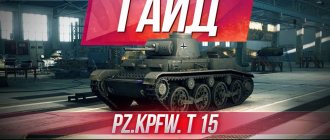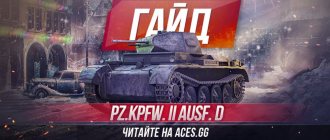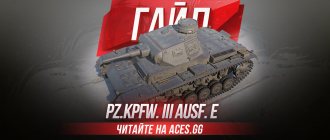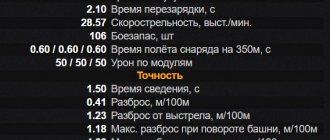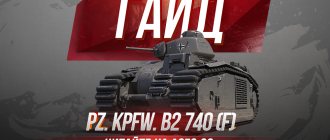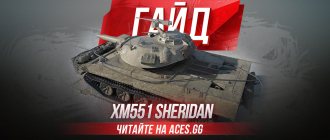Good day and welcome to aces.gg! Friends, today our guest is a unique machine, unprecedentedly strong and I’m not afraid of this word - an immovable tank. We are talking about the king of the sandbox, the German light tank of the third level, in front of you is the Pz.Kpfw. II Ausf. J guide
.
Of course, many people want to get this unit for their hangar, but the car still remains very rare. To the question that interests everyone: “ Pz.Kpfw. II Ausf. J where to get it
? The answer is quite simple, you can only get it by purchasing a special German World of Tanks gift set, which comes with a bonus code.
TTX Pz.Kpfw. II Ausf. J
The main reason why our tank is the king of the sandbox is its survivability parameters. Let's start with the fact that we have a good margin of safety by the standards of our classmates, but more importantly, Pz.Kpfw. II Ausf. J characteristics
the bookings are simply amazing.
At the third level, there are practically no tanks that can penetrate us with a standard shell, and not all of them are capable of inflicting damage on us with gold. Of course, you still need to play carefully, but placing Pz.Kpfw. II Ausf. J World of Tanks
diamond shape, you can practically not be afraid of anything, even our sides inspire fear and awe in enemies.
However, superior armor comes at a price, and the bargaining chip is mobility. We have a very meager engine at our disposal, which is why our dynamics are very weak, as well as maneuverability. Yes, Pz.Kpfw. II Ausf. J tank
has a good maximum speed, but you can only gain it by going down a steep mountain.
By the way, the basic viewing range of our today’s hero is quite good, 320 meters is quite enough, besides, if desired, this indicator can be improved.
The last thing you should know about is the Pz.Kpfw tank. II Ausf. J
endowed with a preferential level of combat, but in the fight against fours we no longer seem so formidable.
gun
The situation with weapons is quite controversial, and you can remain the king of the sandbox only by knowing certain nuances, as well as fulfilling certain conditions.
The first thing you need to know about is the Pz.Kpfw. II Ausf. J gun
costs the first level, which is why our armor penetration with a basic shell is very weak and if you want to play comfortably, you will have to load a full load of gold ammunition, this pleasure, to put it mildly, is not cheap.
In terms of damage, we have a machine gun on board with 10 rounds in its magazine. The rate of fire here is very high, but to send even a classmate, Pz.Kpfw. II Ausf. J WoT
should discharge 2-3 drums. Here you should rejoice at the very fast reloading of the drum.
As for accuracy and shooting comfort, everything is again at a high level. Despite the fact that our cannon has a wide spread, the Pz.Kpfw. II Ausf. J tank
It has very fast convergence and good stabilization. The vertical aiming angles are also pleasantly surprising; the barrel goes down 10 degrees.
Pz. II J Jedi TTX
About the armor. This is its most significant and significant characteristic. The front of the hull/turret is 80 mm, the sides/ rear of the hull/turret are 50 mm each. This is enough to confidently tank most hits.
About mobility. Everything is “not very good” here. Engine power - 160 hp. which gives just under 9 hp/ton. Maximum speed - 31 km.h. Turning speed - 28 degrees/sec.
About the weapon. No, the Jedi’s mobility is not bad compared to a gun. A lvl 1 gun for a lvl 3 tank. That is, the MS-1 level, namely a 2 cm rapid-fire gun. Penetration of AP/sub-caliber shells - 23/46, damage to AP/sub-caliber shells - 8 and 7 enemy strength points, respectively.
Cost of shells. BB - 3 silver, sub-caliber - 400.
Drum for 10 shells. Reloading is quite fast - high rate of fire with one drum and high reload speed of the drum. There are average vertical aiming angles - gun declination is -10 degrees, aiming is more than 3 seconds, the dispersion of a small-caliber gun at 100 meters is 0.55.
Gun 2cm. Kw.K. 38 (conditionally 1st lvl)
Average penetration
- BB - 24
- Golda - 48
Average damage
- BB - 8
- Golda - 7
Cost of shells
- BB - 3
- Golda - 400
Accuracy - 0.513
Obzor – 242 m
Reloading a projectile in a magazine - 0.13 sec
Drum reload - 5.75 sec
Armor (turret and hull are identical)
- Forehead - 80 mm
- Board - 50 mm
- Feed - 50 mm
Advantages and disadvantages
Almost all of the above indicates that we now have a very strong tank in front of us, a real imbue. But even in such conditions, in order for the German light tank Pz.Kpfw. II Ausf. J World of Tanks
dragged fights, you need to know his strengths and weaknesses. Pros: • Excellent all-round armor; • Very fast-firing gun with fast reloading; • Compact dimensions; • Comfortable vertical aiming angles; • Preferential level of battles. Cons: • Mediocre mobility; • Severe gold addiction.
Sd.Kfz.101 Pz.Kpfw. I
Sd.Kfz.101 Pz.Kpfw. I
The first German tank put into large-scale production was a weakly armed and lightly armored combat vehicle, which, however, allowed the Wehrmacht command to begin deploying tank units and formations. In the 1930s it was widely used for training tank troops. Produced at the Krupp, Henschel, MAN and Wegmann factories from January 1934 to the end of 1938.
SERIAL MODIFICATIONS Pz.IA – Basic model. The hull and turret are welded, the chassis has five road wheels on board, the last of which serves as a guide wheel. The layout, which later became classic for German tanks, had an engine at the rear and a transmission at the front. 477 units produced.
Pz.IB - the chassis is extended by one track roller, the idler wheel is raised from the ground. The weight increased to 6 tons, the length increased to 4430 mm. MG 34 machine guns are installed, with 2250 rounds of ammunition. Engine Maybach NL 38TKRM 100 hp. Otherwise, the design of the tank has remained virtually unchanged. 1016 units produced.
Pz.IC (VK 601) – high-speed reconnaissance tank. Developed by Krauss-Maffei in 1942 as a development of the Pz.I line, but was a completely new vehicle. Combat weight - 8 tons, Maybach HL 45R engine with a power of 150 hp, speed 65 km/h. Armament: 20-mm automatic cannon and MG 34 machine gun. Chassis with staggered track rollers. 40 units produced.
PZ.IF (VK 1801) – differed from the previous modification in the thickness of the frontal armor - 80 mm. Weight 18 tons, speed 24 km/h. Armament: two MG 34 machine guns. 30 units produced.
The Pz.I received its baptism of fire in 1936 in Spain, where 41 vehicles of the PZ.IA variant were sent. German light tanks suffered severe losses from the Republican T-26 and BT-5. Nevertheless, by September 1939, the Wehrmacht had 1,445 Pz.I tanks, which accounted for 46.4% of all Panzerwaffe combat vehicles
Pz.I participated in almost all campaigns of the initial period of the Second World War. On June 22, 1941, the front-line units of the German army had only 74 combat vehicles of this type. The rest were used mainly for training purposes and for conducting counter-guerrilla operations in occupied territories. Individual Pz.Is remained in German tank units until 1943.
The Pz.I served as the basis for the creation of self-propelled artillery units, tractors for transporting ammunition, command and bridge tanks and other special-purpose vehicles.
TACTICAL AND TECHNICAL CHARACTERISTICS OF THE Pz.IA TANK
COMBAT WEIGHT, t: 5.4. CREW, people: 2. OVERALL DIMENSIONS, mm: length – 4020, width – 2060, height – 1720, ground clearance – 295. ARMAMENT: 2 MG 13 (later MG 34) machine guns of 7.92 mm caliber. AMMUNITION: 1525 rounds. AIMING DEVICES: Zeiss T2F2 optical sight with double magnification. RESERVATION, mm: forehead – 18; side, stern – 14; bottom – 5; roof – 7; turret – 15. ENGINE: Krupp M305, 4-cylinder, carburetor, air cooling; power 57 hp (42 kW) at 2500 rpm, displacement 3460 cc. TRANSMISSION: dry double-disc clutch, 5-speed gearbox. CHASSIS: five road wheels per side (the front one is on an individual suspension with a coil spring, the rest are interlocked in pairs, on leaf springs); three support rollers; front drive wheel; The caterpillar is small-linked, double-ridged, 280 mm wide. MAX SPEED, km/h: 57. HIGHWAY RANGE, km: 145. OBSTACLES OVERCOME: climb angle, degrees. - thirty; ditch width, m – 1.4; wall height, m – 0.37; ford depth, m – 0.6. COMMUNICATIONS: shortwave radio station Fu 2.
Equipment for Pz.Kpfw. II Ausf. J
To make your game even more comfortable and fun, you need to properly equip the machine with additional modules. Even given the fact that due to the low level we have little choice, there may be nuances here, so on Pz.Kpfw. II Ausf. J equipment
we can put the following: 1. — all other things being equal, this module is ideal, because it simultaneously boosts several parameters that are most important for us. 2. - this option will give you the opportunity to keep up with most of your classmates in terms of review, and even have an advantage over some. 3. - we have excellent armor, but various landmines, especially artillery ones, can cause a lot of inconvenience, so this choice is completely justified. By the way, this is another advantage when ramming, our tank has an impressive mass.
If the damage from landmines and absorption doesn’t scare you at all, you can change the last point to . Yes, reduce Pz.Kpfw. II Ausf. J WoT
It’s already very fast, but it will be even faster. In other words, in terms of the third module, it's up to you.
Tactics of playing Pz.Kpfw. II Ausf. J
If you look at things sensibly, then in fact, we have a real heavy tank in front of us, and with excellent armor, which is rarely seen in our game now. Due to poor mobility, we can say with confidence that the Pz.Kpfw. II Ausf. J tank
one direction, choosing which you need to press to the end, or not to drive far from the base if it starts to smell like something fried.
At the same time, it is necessary to understand that we have a machine gun on board, which has a limited firing range. In view of everything that has been said on the Pz.Kpfw. II Ausf. J tactics
combat comes down to systematically pushing through lines by approaching and imposing close combat on the enemy.
You can put it entirely on the armor, but it is still better to become a diamond in front of the enemy or opponents, so the Pz.Kpfw tank. II Ausf. J World of Tanks
it's almost impossible to break through. And all the same, it is not always possible to push forward too much, because some are capable of charging gold and then our armor may not withstand it.
All other tips are quite standard: try to keep an eye on the mini-map, beware of artillery and remember that in battles against the fourth levels of Pz.Kpfw. II Ausf. J
is losing its strength, here many will be able to seriously compete with us.
But once you charge the Golda and find yourself in battle with your classmates, you will get a lot of pleasure and unbridled fun. And every battle you can take out a bunch of scalps of defeated opponents without straining at all, but don’t be surprised at the costs for Pz.Kpfw. II Ausf. J WoT
going to -50,000 on silver is common and worth it.
Yuri Pasholok. Long trunk for the German Troika
Home » Real story » History of Wars » Yuri Pasholok. Long trunk for the German Troika
History of WarBooks on the history of tanks
byakin 08/11/2021 1453 0 comments
15
in Favoritesin Favoritesfrom Favorites 8
Yuri Pasholok. Long trunk for the German Troika
History of the Pz.Kpfw.III Ausf.J with the 50 mm KwK 39 L/60 gun
The biggest drama in the history of German tank building during the pre-war and war period is the ZW medium tank, also known as Pz.Kpfw.III. No other tank took as much nerve from the Germans as this combat vehicle. Suffice it to say that the first four production versions of this tank were actually test versions. Each of them received its own version of the chassis, and none of them was successful. It was only in 1938 that the ZW38 chassis, better known as the Pz.Kpfw.III Ausf.E, was formed. The tank, which received a chassis with torsion bar suspension, was supposed to accelerate to almost 70 km/h. Theoretically, he could do this, but it turned out that the Maybach Variorex 10-speed semi-automatic gearbox turned out to be capricious, and the road wheel tires began to quickly fail after reaching speeds above 40 km/h. The battle with the Maybach Variorex gearbox took time, so the Pz.Kpfw.III Ausf.E did not begin production until the beginning of 1939. Moreover, the production of Pz.Kpfw.III in 1939 was frankly overwhelmed. For the entire year, only 206 tanks were delivered, and actual production began only in September. Problems with the Maybach Variorex led to the fact that later it was necessary to switch to a 6-speed ZF SSG 77 gearbox. With it, the tank began to develop a quite familiar 40 km/h.
One of the very first examples of the PzIII Ausf.J, manufactured by Alkett in December 1941. A vehicle from the 24th Tank Division, summer 1942. If the tank did not die in battle in the second half of 1942, its fate was the Stalingrad cauldron
Despite all the problems that arose, the Pz.Kpfw.III gradually became a completely successful vehicle. By May 1940, it had become the most popular medium tank in the German army, and its development reserves made it possible to significantly improve its performance. First of all, this concerned armor protection and weapons. In July 1940, production of the Pz.Kpfw.III began with 50-mm KwK 38 L/42 guns. This weapon was based on the design of the Pak 38 anti-tank gun. However, the weapon had to be slightly redesigned, since the Pak 38 was not suitable in its pure form. In addition to the fact that the barrel should not protrude beyond the dimensions of the vehicle, it was also necessary to reduce the dimensions of the ammunition. The result was a gun that was weaker than the 5 cm Pak 38. And significantly weaker. The KwK 38 armor-piercing projectile, at a distance of 500 meters, pierced a plate just over 40 mm thick, installed at an angle of 60 degrees from the vertical. Thus, back in the second half of the 40s, the prospect of replacing the gun with something more powerful loomed. The German Armaments Directorate, however, was in no hurry at first.
In the manual dated March 1942, the tank was also called Ausf.J, but soon it was renamed Ausf.L
In March 1941, production of the 8.Serie/ZW, also known as the Pz.Kpfw.III Ausf.J, began. This was the pinnacle of the ZW's evolution; then the tank's chassis was modified in a minimal way. For its time, it turned out to be a quite successful tank, especially compared to what the British were doing then. The Germans did not yet know about the T-34, however, back in June 1940, the question of further strengthening of weapons was raised. At first, experts, including Porsche, Fichtner, Todt and others, spoke out against this decision. Only Rheinmetall-Borsig remained silent. On February 18, 1941, Hitler, who was the main initiator of the strengthening of armaments, repeated his demand. Again there was a friendly refusal, but then Paul Panten, director of the Alkett plant, the tank division of Rheinmetall Borsig, took the floor. Apparently, design work in this direction was already underway at Alkett. Panten agreed to develop a prototype gun. The next day, Hitler gave urgent instructions to build one model each of the Pz.Kpfw.III and Pz.Kpfw.IV with a 60-caliber gun. The first mock-up was shown on March 19, and on the 31st an optimistic forecast appeared for the launch of 5 KwK L/60 in 4-5 months. This weapon did not take root on the Pz.Kpfw.IV, but the first Pz.Kpfw.III Ausf.J with 5 cm KwK 39 L/60 went into production in December. We will talk about these tanks.
The ammunition of the 5 cm KwK 39 L/60 was longer than that of the 42-caliber gun
Unfortunately, I couldn’t find a photo of the first sample 5 cm KwK L/60 on the Pz.Kpfw.III, but judging by the layout of this gun on the Pz.Kpfw.IV, it initially had a muzzle brake. However, it quickly became clear that we could do without it. It may seem that the alteration itself was simple, but this is not entirely true. The balancing and recoil mechanism had to be redone, and a TZF 5e telescopic sight was also installed. Due to the installation of a new balancing mechanism, additional holes for fastenings appeared on the roof of the tower. But this is only a tower. The fact is that the 5 cm KwK 39 L/60 was converted to 5 cm Pak 38 ammunition, and their cartridge case was 133 mm longer. It seemed like there was a small difference, but in reality there was no difference. This meant that the styling would have to be redone. On tanks with 5 cm KwK 38 L/42, ammunition was placed in vertical racks stacked on top of each other. In the case of the 5 cm KwK 39 L/60, the second row of racks had to be removed and the stacking had to be completely redone. Accordingly, the ammunition supply decreased from 99 to 84 unitary rounds of 50 mm caliber. In addition, the 672 mm gun extended beyond the dimensions of the tank chassis. I would like to say “entirely,” but after a year it was “only.” After the “Tiger” and “Panther”, such an extension of the barrel beyond its dimensions looked like a mere trifle.
Due to the increase in the length of unitary cartridges, the racks for ammunition became single-story
The appearance of the 5 cm KwK 39 L/60 turned out to be very useful. In the fall of 1941, the Germans even began to notice the T-34, against which the 42-caliber gun had extremely limited capabilities for destruction. There was no need to talk about the KV-1. It would seem that it’s time to completely switch to a new system. But it was not there! Of the 171 Pz.Kpfw.III Ausf.Js produced in December 1941, only 40 vehicles were equipped with new guns. Moreover, the installation of 5 cm KwK 38 L/42 continued further. In total, in 1942, another 280 tanks with 42-caliber guns were delivered. The reason is simple - there was a backlog of guns, plus it was necessary to change some parts, including stowage. So almost a third of the tanks produced in January-April 1942 (a total of 865 of them were delivered during this time) had old guns.
Tank with serial number 72527, manufactured in December 1941 at the MAN plant. This is the same tank that stands in the Patriot Park
Another interesting point was that initially 5 cm KwK 39 L/60 was supposed to be a temporary phenomenon. The fact is that in November 1941, the idea of producing the Pz.Kpfw.III with Pz.Kpfw.IV turrets and 75-mm KwK 40 L/43 guns appeared. This combination, designated PzIII Ausf.K, looked more promising. It would seem that in such a situation the Pak 38 ballistic gun would not last long on the PzIII, but by the spring of 1942, an extremely unpleasant thing became clear. The fact is that the proposed combination turned out to be too heavy. The installation of a new turret and gun led to a shift of the center of gravity forward; it was necessary to completely redo the chassis. Theoretically, such changes were possible, but they turned out to be fraught with a drawdown in tank production. Therefore, on March 19, 1942, a command was issued to stop work on the PzIII Ausf.K. Instead of a temporary phenomenon, the 5 cm KwK 39 L/60 became a weapon with no alternative.
The tank fought as part of the 15th Tank Regiment of the 11th Tank Division and had a basic sand color. The car was supposed to go to Africa, but ended up on the Soviet-German front
Due to the failure of the Pz.Kpfw.III Ausf.K production, the current tank was renamed. In April 1942, the Pz.Kpfw.III Ausf.L index appeared, but it was also unique. At Daimler-Benz the designation Pz.Kpfw.III Ausf.J lasted until April 1942 inclusive, and Henschel's first Ausf.L appeared in June 1942. This was all very reminiscent of the situation with the renaming of the Pz.Kpfw.IV Ausf.F2 to Ausf.G. In total, what can be identified as a Pz.Kpfw.III Ausf.J with a long-barreled gun was produced in quantities of about 450 examples. The number is relative, besides, external changes can belong to both the last Ausf.J and the first Ausf.L.
There is a hole to the left of the driver's viewing device. It's also on the museum tank.
The very first long-barreled Pz.Kpfw.III Ausf.J did not differ in anything other than the gun and corresponding changes to the turret from tanks with the 5 cm KwK 38 L/42. An excellent example of this is the tank with serial number 72527, which was produced by MAN in December 1941. Since December, the engine access hatches on the engine plate have been made single-leaf, but on the specified vehicle they still have two doors. The hatches on the upper aft plate were also enlarged, but they are also of the old type. A very similar situation with spaced armor. The very first tank received it back in December 1941, but actually the spaced armor went into large production in April 1942. It was carried by both the last Ausf.J and the first Ausf.L. Not to mention the fact that later sets of spaced armor were installed on previously produced vehicles. The situation is exactly the same with the inspection hatches on the sides of the tower. Initially, they wanted to remove them back in January 1942, but in fact the first tanks without these hatches (and also without the front loading hatch, in the movable armor to the right of the gun) appeared in April 1942. But in fact, the tanks with hatches could have been manufactured in June or July.
On the engine plate there are additional air intakes, typical for the tropical version.
The first long-barreled Ausf.Js appeared at the front somewhere closer to February 1942. In reality, they went into battle later - closer to spring. The gun made it possible to increase the range of destruction of the T-34, however, you shouldn’t delude yourself too much. Firstly, the difference between the 42-caliber and 60-caliber guns was not as big as it might seem. Secondly, in the “two tanks drove into an open field” competition, so beloved by some historians, the T-34 had the advantage. True, it must be borne in mind that the fight against tanks was important, but not the only task of the PzIII. This is also hinted at by the fact that out of 84 shells, 34 were armor-piercing. 8 of them could have been sub-caliber, but you shouldn’t delude yourself about them either. Subcalibers were useful at close and medium ranges, and then there was a sharp drop in armor penetration.
Configuration of the long-barreled version of the Pz.Kpfw.III Ausf.J at the time of production discontinuation. The first Ausf.L looked exactly the same, in fact they are one and the same
The peak use of the Pz.Kpfw.III Ausf.J with 60-caliber guns occurred in the second half of 1942, as well as in the battles of the spring of 1943. The bulk of these tanks were destroyed in the battles of late 1942 and early 1943, although some survived to the Kursk Bulge. Only one such tank has survived to this day. We are talking about the very same 72527 issue of December 1941. The tank became part of the 15th Tank Regiment of the 11th Tank Division, where it fought during the second half of 1942. The vehicle bore turret number 24; judging by the photographs taken in 1943, it did not have winter camouflage. But there was a basic color, which stupefies some visitors to the museum sector of Patriot Park.
The peak use of this version of the tank occurred in the second half of 1942
The reason for this strange reaction is that the car carried the base color sand (RAL 1002 according to the RAL palette). This is the standard base color for Afrika Korps tanks in 1942. Where do the “Africans” come from in our latitudes? The answer is very simple: in the summer of 1942, some of the tanks that were planned to be transferred to North Africa were sent to units that fought at Stalingrad and in the Caucasus. 11th, 13th, 23rd, 24th tank divisions, the list is definitely not complete. Some of the assault gun divisions also had sand StuG 40s.
This is what the Pz.Kpfw.III Ausf.J with serial number 72527 looks like now. All sorts of leftover details appeared during the latest “restoration” to date.
There is no exact information about where exactly this tank was lost. It has a through hole in the front plate of the turret box. In 1943, the tank ended up at the NIBT Test Site, and then it remained in the museum at the test site. The vehicle successfully survived scrap metal sales and the use of some tanks as targets, and even managed to star in a couple of films. Since 1972, it has been in pavilion No. 6 of the Museum of Armored Vehicles. She remained there until the museum became part of the Patriot Park. In 2014, the tank was restored to running condition. It was returned to its original color and partially original markings.
The quality of manufacturing of a number of elements raises a lot of questions for the so-called restorers. At least they didn’t take out the original engine, like on the T-40, because they couldn’t fix it, and thank you for that...
There were fears that after the tank was put into operation, according to an unkind tradition, it would begin to be rolled away in films and reconstructions. Fortunately, the Pz.Kpfw.III Ausf.J escaped our filmmakers. It was moved to the museum sector of Patriot Park, where it is now located. On the starboard side it is possible to look inside through the hatches; there is lighting inside. Quite recently, “restoration” (in quotes because this is a collective farm tuning, not a restoration) once again touched the car, for some reason attaching to it all sorts of elements that either were not on it, or were made by crooked good hands. Fortunately, this whole garage installation is reversible, when sane people appear, it will be possible to put the car in order. At least there is hope for that.
List of sources:
- USNARA
- TsAMO RF
- Panzer Tracts No.3-3 Panzerkampfwagen III Ausf.J, L, M, und N, development and production from 1941 to 1943, Thomas L. Jentz, Hilary Louis Doyle, 2009
- Photo archive of the author
- eBay
source: https://zen.yandex.ru/media/yuripasholok/dlinnyi-hobot-dlia-nemeckoi-troiki-60fde9a5237ef80467e00c4d

